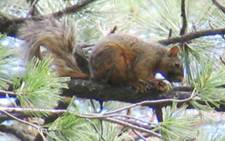Sandy Doumas
Factors influencing habitat use by wildlife relative to landscape disturbance
-
Time Period: August, 2006 – December, 2010
-
Location: The Chiricahua Mountains, AZ, U.S.A.
 Major Questions: I am interested in factors influencing habitat use by wildlife relative to landscape disturbance, especially fire. Fire is a necessary and recurring disturbance in many ecosystems with profound effects over time on vegetation composition, structure, and landscape pattern. The effects of fire on ecosystems have been complicated by decades of fire suppression followed by reintroduction of fire into fire-deprived ecosystems. Historically, fire-adapted forests were relatively resilient to fire, and some current forest management techniques seek to restore forests to historical composition, structure, and landscape pattern to recreate fire-resiliency. I study habitat use by native wildlife to better understand the response of wildlife to alterations of vegetation structure and pattern following the reintroduction of fire. Specifically, I study habitat use of the Mexican fox squirrel, Sciurus nayaritensis chiricahuae, in conifer forests of the Chiricahua Mountains of SE Arizona, which have experienced several recent fires.
Major Questions: I am interested in factors influencing habitat use by wildlife relative to landscape disturbance, especially fire. Fire is a necessary and recurring disturbance in many ecosystems with profound effects over time on vegetation composition, structure, and landscape pattern. The effects of fire on ecosystems have been complicated by decades of fire suppression followed by reintroduction of fire into fire-deprived ecosystems. Historically, fire-adapted forests were relatively resilient to fire, and some current forest management techniques seek to restore forests to historical composition, structure, and landscape pattern to recreate fire-resiliency. I study habitat use by native wildlife to better understand the response of wildlife to alterations of vegetation structure and pattern following the reintroduction of fire. Specifically, I study habitat use of the Mexican fox squirrel, Sciurus nayaritensis chiricahuae, in conifer forests of the Chiricahua Mountains of SE Arizona, which have experienced several recent fires.
